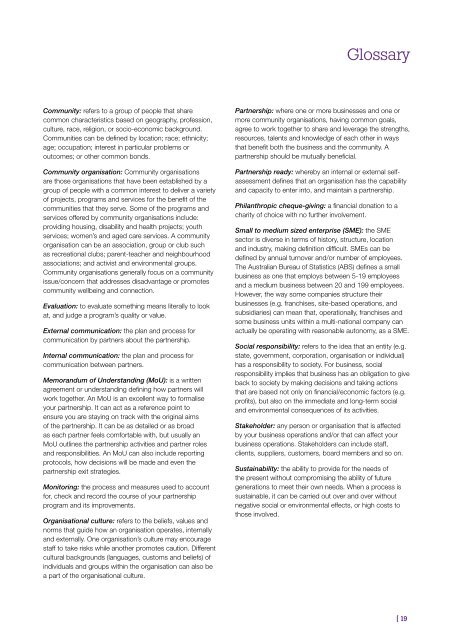partnering with community organisations - Department of Families ...
partnering with community organisations - Department of Families ...
partnering with community organisations - Department of Families ...
Create successful ePaper yourself
Turn your PDF publications into a flip-book with our unique Google optimized e-Paper software.
Glossary<br />
Community: refers to a group <strong>of</strong> people that share<br />
common characteristics based on geography, pr<strong>of</strong>ession,<br />
culture, race, religion, or socio-economic background.<br />
Communities can be defined by location; race; ethnicity;<br />
age; occupation; interest in particular problems or<br />
outcomes; or other common bonds.<br />
Community organisation: Community <strong>organisations</strong><br />
are those <strong>organisations</strong> that have been established by a<br />
group <strong>of</strong> people <strong>with</strong> a common interest to deliver a variety<br />
<strong>of</strong> projects, programs and services for the benefit <strong>of</strong> the<br />
communities that they serve. Some <strong>of</strong> the programs and<br />
services <strong>of</strong>fered by <strong>community</strong> <strong>organisations</strong> include:<br />
providing housing, disability and health projects; youth<br />
services; women’s and aged care services. A <strong>community</strong><br />
organisation can be an association, group or club such<br />
as recreational clubs; parent-teacher and neighbourhood<br />
associations; and activist and environmental groups.<br />
Community <strong>organisations</strong> generally focus on a <strong>community</strong><br />
issue/concern that addresses disadvantage or promotes<br />
<strong>community</strong> wellbeing and connection.<br />
Evaluation: to evaluate something means literally to look<br />
at, and judge a program’s quality or value.<br />
External communication: the plan and process for<br />
communication by partners about the partnership.<br />
Internal communication: the plan and process for<br />
communication between partners.<br />
Memorandum <strong>of</strong> Understanding (MoU): is a written<br />
agreement or understanding defining how partners will<br />
work together. An MoU is an excellent way to formalise<br />
your partnership. It can act as a reference point to<br />
ensure you are staying on track <strong>with</strong> the original aims<br />
<strong>of</strong> the partnership. It can be as detailed or as broad<br />
as each partner feels comfortable <strong>with</strong>, but usually an<br />
MoU outlines the partnership activities and partner roles<br />
and responsibilities. An MoU can also include reporting<br />
protocols, how decisions will be made and even the<br />
partnership exit strategies.<br />
Monitoring: the process and measures used to account<br />
for, check and record the course <strong>of</strong> your partnership<br />
program and its improvements.<br />
Organisational culture: refers to the beliefs, values and<br />
norms that guide how an organisation operates, internally<br />
and externally. One organisation’s culture may encourage<br />
staff to take risks while another promotes caution. Different<br />
cultural backgrounds (languages, customs and beliefs) <strong>of</strong><br />
individuals and groups <strong>with</strong>in the organisation can also be<br />
a part <strong>of</strong> the organisational culture.<br />
Partnership: where one or more businesses and one or<br />
more <strong>community</strong> <strong>organisations</strong>, having common goals,<br />
agree to work together to share and leverage the strengths,<br />
resources, talents and knowledge <strong>of</strong> each other in ways<br />
that benefit both the business and the <strong>community</strong>. A<br />
partnership should be mutually beneficial.<br />
Partnership ready: whereby an internal or external selfassessment<br />
defines that an organisation has the capability<br />
and capacity to enter into, and maintain a partnership.<br />
Philanthropic cheque-giving: a financial donation to a<br />
charity <strong>of</strong> choice <strong>with</strong> no further involvement.<br />
Small to medium sized enterprise (SME): the SME<br />
sector is diverse in terms <strong>of</strong> history, structure, location<br />
and industry, making definition difficult. SMEs can be<br />
defined by annual turnover and/or number <strong>of</strong> employees.<br />
The Australian Bureau <strong>of</strong> Statistics (ABS) defines a small<br />
business as one that employs between 5-19 employees<br />
and a medium business between 20 and 199 employees.<br />
However, the way some companies structure their<br />
businesses (e.g. franchises, site-based operations, and<br />
subsidiaries) can mean that, operationally, franchises and<br />
some business units <strong>with</strong>in a multi-national company can<br />
actually be operating <strong>with</strong> reasonable autonomy, as a SME.<br />
Social responsibility: refers to the idea that an entity (e.g.<br />
state, government, corporation, organisation or individual)<br />
has a responsibility to society. For business, social<br />
responsibility implies that business has an obligation to give<br />
back to society by making decisions and taking actions<br />
that are based not only on financial/economic factors (e.g.<br />
pr<strong>of</strong>its), but also on the immediate and long-term social<br />
and environmental consequences <strong>of</strong> its activities.<br />
Stakeholder: any person or organisation that is affected<br />
by your business operations and/or that can affect your<br />
business operations. Stakeholders can include staff,<br />
clients, suppliers, customers, board members and so on.<br />
Sustainability: the ability to provide for the needs <strong>of</strong><br />
the present <strong>with</strong>out compromising the ability <strong>of</strong> future<br />
generations to meet their own needs. When a process is<br />
sustainable, it can be carried out over and over <strong>with</strong>out<br />
negative social or environmental effects, or high costs to<br />
those involved.<br />
[ 19




![pdf [107kB] - Department of Families, Housing, Community Services](https://img.yumpu.com/51272499/1/190x245/pdf-107kb-department-of-families-housing-community-services.jpg?quality=85)










![Land Claim - pdf [278kB] - Department of Families, Housing ...](https://img.yumpu.com/47002639/1/184x260/land-claim-pdf-278kb-department-of-families-housing-.jpg?quality=85)

![Borroloola Land Claim - pdf [299kB] - Department of Families ...](https://img.yumpu.com/46103973/1/184x260/borroloola-land-claim-pdf-299kb-department-of-families-.jpg?quality=85)